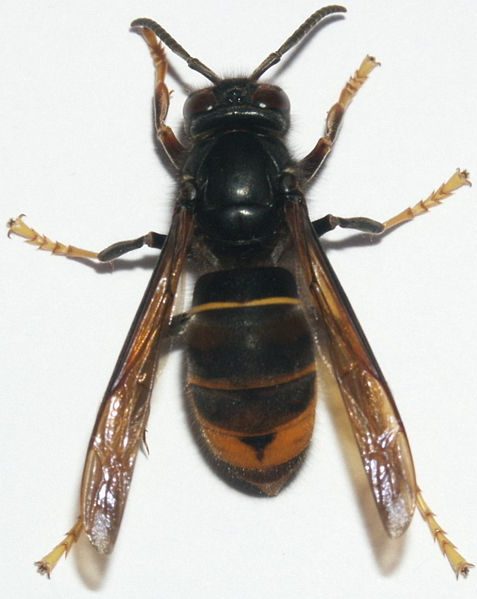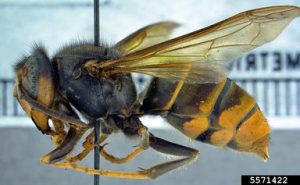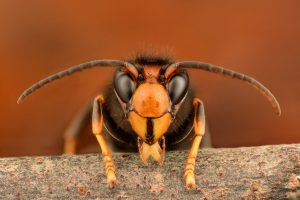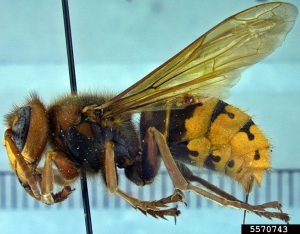2023 saw a record number of confirmed Asian Hornet sightings in the UK, with nests identified and destroyed in North and East Yorkshire

An Asian Hornet (Vespa velutina) in flight © Alain C.
Concerning spread of invasive species
In recent years, the United Kingdom has faced a growing threat from invasive species that disrupt local ecosystems and threaten native wildlife. One such invader is the Asian hornet (Vespa velutina), a predatory insect native to Southeast Asia. The Asian hornet’s arrival in the UK has raised concerns among conservationists, beekeepers, and the general public due to its potential impact on local biodiversity and ecosystems.
Origins of the Asian Hornet Invasion
The Asian hornet first appeared in France in 2004 and subsequently spread across Europe. Its arrival in the UK was confirmed in 2016, when several sightings were reported, particularly in the southern regions of England. Since then, efforts have been made to monitor and control the spread of this invasive species. 2023 saw the largest increase of confirmed Asian Hornet sightings, with 70 nests in 54 locations being destroyed. In October 2023 there were confirmed sightings of Asian hornets in Hull, East Yorkshire, and Yarm in North Yorkshire.
Updated sighting can be found at Asian Hornet Sightings and Incursion Map | British Beekeepers Association (bbka.org.uk)
How to tell an Asian Hornet from a European Hornet
Asian Hornet
European Hornet
-
Smaller than a European hornet
-
Typically between 20mm and 30mm in length
-
Tips of legs are yellow
-
Thorax is dark brown to black
-
Abdomen is dark brown to black with orange to yellow segments at the bottom
-
Head is orange from the front and dark brown or black from above

© BlueGinko

© Allan Smith-Pardo

© Gilles San Martin

© Hanna Royals

© Allan Smith-Pardo

© Judy Gallagher
-
Largest native hornet
-
Typically between 25mm and 35mm
-
Legs and thorax are reddish brown
-
Abdomen is predominantly yellow with some black stripes
-
Head is yellow from the front and red from the top

Why is the Asian Hornet such a concern?
Predatory Behaviour:
Asian hornets are voracious predators, primarily targeting honeybees and other pollinators. They pose a significant threat to honeybee populations, which are already under stress due to factors such as habitat loss and pesticide use.
The European Honeybee has not developed the same defence mechanisms as the Asian Honeybee to the Asian Hornet, which leaves them especially vulnerable to attack, with entire hives being destroyed.
Impact on Biodiversity:
The presence of Asian hornets can lead to a decline in native insect populations, which can have cascading effects throughout the food chain. Many pollinating insects are predated by Asian hornets, which can in turn have a negative impact on wildflowers and crops which rely on insect pollination. Whilst a large number of bird species rely on insects as a food source, any decline in insect numbers will reduce the food available to these birds, leading to a potential decline in bird populations as well.

An Asian Hornet (Vespa velutina) displaying “hawking behaviour” in front of a beehive © Danel Solabarrieta
Control and Management Efforts

Removal of an Asian Hornet nest © NNSS
The UK government, in collaboration with local beekeeping associations and conservation organizations, has taken steps to control the spread of Asian hornets. These efforts include:
-
Monitoring and Reporting: Encouraging citizens to report Asian hornet sightings to local authorities to track their spread and plan effective control measures.
-
Nest Removal: Trained professionals conduct nest removals to prevent the establishment of large colonies.
-
Public Awareness: Raising public awareness about the Asian hornet and educating people on how to distinguish it from native species, especially the European hornet.
-
Research and Development: Investing in research to develop better methods for detecting and controlling Asian hornet populations.
How to report sightings
Sightings should be sent in via the links below:
- Asian Hornet Watch app for iPhone (external link)
- Asian Hornet Watch app for android (external link)
- Online recording form (external link)
You can also email us to report an Asian hornet sighting. Please send a photograph and location details. Do not under any circumstances disturb or provoke an active hornets’ nest.





